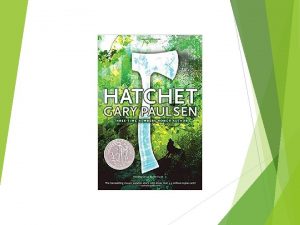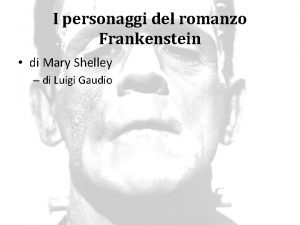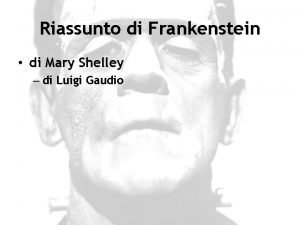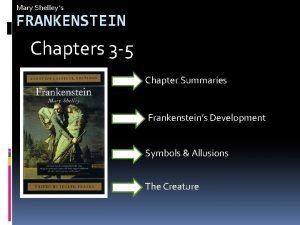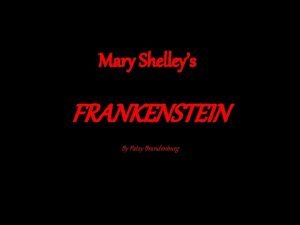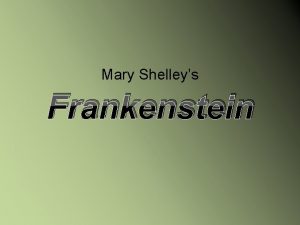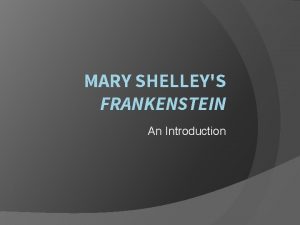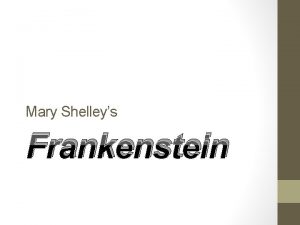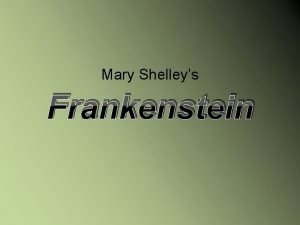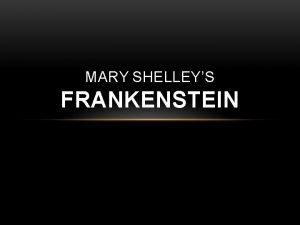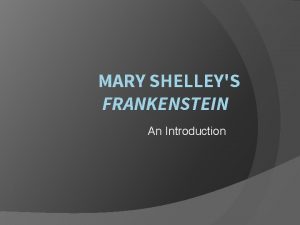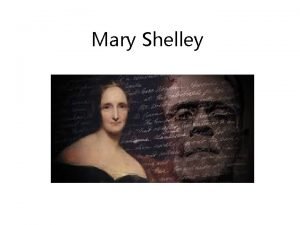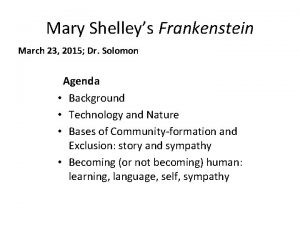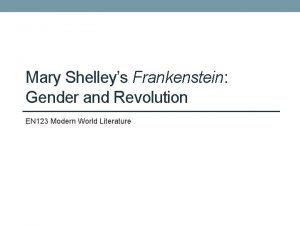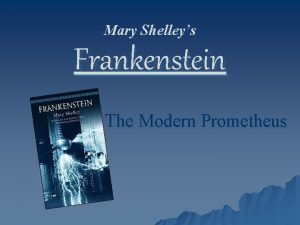Mary Shelleys FRANKENSTEIN The original title was Frankenstein






















- Slides: 22

Mary Shelley’s FRANKENSTEIN

The original title was Frankenstein or, The Modern Prometheus was a mythological god who, according to one story, steals fire from Jupiter to help the mortals on earth. Another version of this myth is that Prometheus actually creates a human being by breathing life into a clay body. 1945

The author, Mary Shelley, was born Mary Wollstonecraft in London in 1797 and died in 1851 at the age of 54 from a brain tumor. Shelley was 19 years old when she wrote this Gothic novel in 1816. At the time she was married to a poet, Percy Shelley, who helped her with the editing process of this novel. 1931

Mary wrote the novel one summer while she vacationed at Lake Geneva in Switzerland. The weather was unseasonably cold. For entertainment, Mary Shelley, her husband (poet) Percy Bysshe Shelley, (poet) Lord Byron, and Jane Clairmont sat around reading ghost stories. 1931

On June 15, 1816, a challenge was issued among the four of them to see who could write the most terrifying story. Mary Shelley’s story is based on her life experiences, her dreams, and scientific research and experiments of that time period. 1931

Mary Shelley had previously suffered with nightmares after her daughter died two weeks after birth. Repeatedly Shelley dreamed her baby was just cold, and that she herself brought her daughter back to life after massaging the infant’s lifeless body while sitting next to a warm fire. 1931

On June 15, 1816, Shelley experienced a different nightmare in which she dreamed that “a pale student of ‘unhallowed arts’ creates a living being from dead parts” (“Frankenstein” x). [unhallowed: against what is considered holy and sacred; immoral and unethical according to society’s standards] 1931

That dream was the basis for her Gothic story. Mary Shelley was the only one out of the group to finish her tale of terror. Mary Shelley’s Gothic novel was published in 1818 when she was just 21. She went on to publish other works, but none ever matched the popularity of FRANKENSTEIN. 1931

Mary Shelley’s novel wasn’t based on her dreams alone. In the early 1800’s, scientists were obsessed with finding a way to bring the dead back to life. Shelley found this idea fascinating and kept current with all new science experiments taking place during her time. Luigi Galvani was one scientist who believed that “electricity” was the life force for living beings.

Galvani would take dead animals and shock their bodies with high currents of electricity. The corpse would jolt when shocked with electrical currents. Luigi’s nephew, Giovanni Aldini, took the experiment one step further. In London, on January 17, 1803, he publicly performed this experiment on the corpse of a human being, a prisoner who had been executed by hanging.

Giovanni attached live wires to the corpse: 120 plates of zinc and 120 plates of copper. Giovanni reported, “the jaw began to quiver, the adjoining muscles were horribly contorted, and the left eye actually opened”(Frankenstein” xx). The muscles of the corpse were shocked to such a degree that the corpse appeared “animated” to the public.

With Frankenstein, the sci-fi era began. The novel contains the 3 elements essential for all science fiction work: (1)“it’s based on valid scientific research; (2)gives a persuasive prediction of what science might achieve in the future; (3) and it offers a humanistic critique of the benefits and dangers of either the achievement or scientific thought” (xx).

Romantic Movement: (1770 -1870) This movement is not about “romance or love” but about disillusioned liberals who were tired of the common people being oppressed by tyrant rulers. This time period occurred simultaneously with revolutions around the world: the American R. 1776, the French R. 1789, the French Reign of Terror 1793. Nature imagery is a key element in Romantic literature because human tyranny could not control nature. For the Romantics, nature represented peace and they believed that all emotional healing came from nature. [Nature imagery is abundant in Frankenstein. ]

Gothic Literature : an offshoot of 1997 Romantic literature. “Along with nature having the power of healing, Gothic writers gave nature the power of destruction. Many storms arise in the book, including storms the night the creature comes to life… The most common feature of Gothic literature is the indication of mood through the weather. When bad things are going to happen in a Gothic novel, the reader knows it because there is inevitably a storm outside” (Grudzina).

In addition, Gothic literature is “a style of fiction, especially in the late 18 th century and early 19 th century, with historical and picturesque settings, an atmosphere of mystery, gloom and terror, supernatural or psychological plot elements, with violent, gruesome deaths” (Webster). The setting is usually in medieval castles built in the Gothic style of architecture—with secret passageways, dungeons, and towers. The name Frankenstein is taken from a castle in Germany where an alchemist experimented with dead bodies.

Ali. Allusions in Novel • Paradise Lost by John Milton – story of man’s fall from innocence to painful knowledge; Victor can be compared to Adam, Satan, and Eve; his creation can be compared to Adam and Satan • The Rime of the Ancient Mariner by Samuel Taylor Coleridge, like the narrator’s tale, the story is told as a warning and a confession

Major Characters • Victor Frankenstein – protagonist, product of an idealistic Enlightenment education; fueled by possibilities of science and a desire for acclaim; becomes obsessed with creating life from spare body parts. Rational demeanor dissolves and by story’s end, he is consumed by primitive emotions of fear and hatred.

Major Characters • The Creature - never named; is Victor’s doppelganger (alter ego); Creature rationally analyzes the society that rejects him; sympathetic character, admires people and wants to be a part of human society; only results in violence when he is repeatedly rejected

Supporting Characters • Henry Clerval – Victor’s childhood friend; true romantic, wants to leave mark on the world, but never loses sight of “the moral relations of things” • Elizabeth – adopted as an infant by Victor’s family; marries Victor • Robert Walton – Arctic explorer who’s obsessed with gaining knowledge and fame; rescues Victor in the Arctic; tells the story

Symbols • • • White/light= knowledge Ice = danger Lightning = nature’s power Nature = acceptance, nurturing, calm Mountains= sublime in nature

Themes Center on the Following • Consequences of irresponsibility in the pursuit of knowledge • Consequences of pride • Consequences of society’s rejection of someone who is unattractive • Destructive power of revenge • Relationship between nature and nurture

Works Cited “Frankenstein. ” U. S. National Library of Medicine. N. p. 13 February 2002. Web. 5 October 2011. Grudzina, Rebecca. Teaching Unit: Individual Learning Packet. Cheswold: Prestwick House Inc. , 2004. Print.
 Hatchet genre
Hatchet genre Frankenstein di mary shelley
Frankenstein di mary shelley Frankenstein summary
Frankenstein summary Frankenstein riassunto capitoli
Frankenstein riassunto capitoli Mary shelley frankenstein summary
Mary shelley frankenstein summary Theme of frankenstein
Theme of frankenstein Chapter summaries of frankenstein
Chapter summaries of frankenstein Frankenstein ch 3 summary
Frankenstein ch 3 summary Who wrote the letters in frankenstein
Who wrote the letters in frankenstein Mary shelley frankenstein biography
Mary shelley frankenstein biography Mary wollstonecraft mary a fiction
Mary wollstonecraft mary a fiction Title fly and title page
Title fly and title page Title title
Title title Bổ thể
Bổ thể Từ ngữ thể hiện lòng nhân hậu
Từ ngữ thể hiện lòng nhân hậu Diễn thế sinh thái là
Diễn thế sinh thái là Tư thế ngồi viết
Tư thế ngồi viết Ví dụ về giọng cùng tên
Ví dụ về giọng cùng tên Frameset trong html5
Frameset trong html5 Phép trừ bù
Phép trừ bù Hát lên người ơi
Hát lên người ơi Khi nào hổ con có thể sống độc lập
Khi nào hổ con có thể sống độc lập đại từ thay thế
đại từ thay thế
